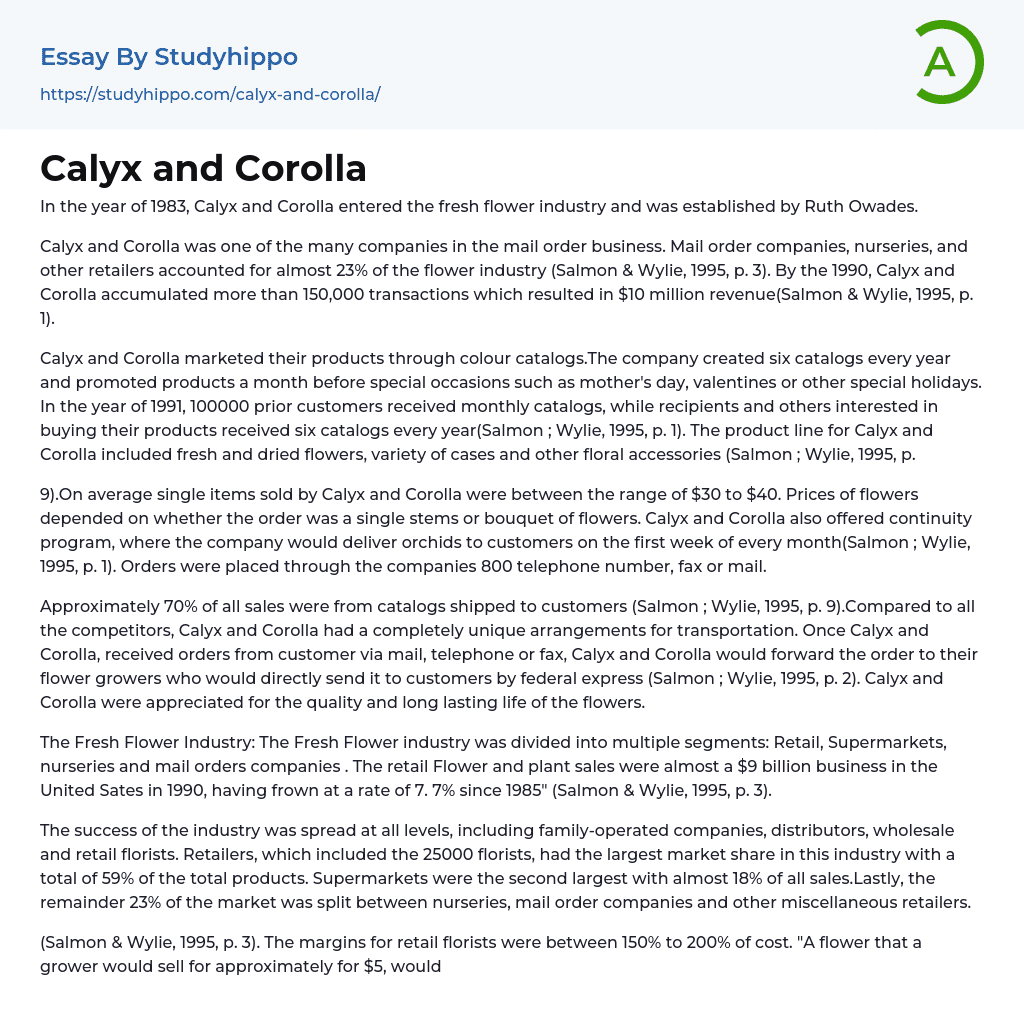In 1983, Ruth Owades founded Calyx and Corolla to establish a presence in the fresh flower industry.
Among the various businesses in the flower industry, Calyx and Corolla was a company involved in mail ordering, like many nurseries and retailers. In fact, almost 23% of the flower industry consisted of these types of businesses (Salmon & Wylie, 1995, p. 3). As of the 1990s, Calyx and Corolla had conducted over 150,000 transactions, generating revenue of $10 million (Salmon & Wylie, 1995, p. 1).
Calyx and Corolla utilized colorful catalogs to market their products, creating six catalogs annually. They advertised items a month prior to special occasions including Mother's Day and Valentine's Day. In 1991, 100,000 previous customers received monthly catalogs, while interested buyers and recipients were sent six catalogs per year (Salmon ; Wylie, 1995
..., p. 1). The Calyx and Corolla product selection consisted of fresh and dried flowers, as well as various cases and other floral accessories (Salmon ; Wylie, 1995, p.
In line with Salmon and Wylie's (1995, p. 1) findings, Calyx and Corolla commonly retailed single items priced between $30 to $40, depending on whether they were sold as individual stems or part of a bouquet. Apart from this, the company had a subscription plan where clients could get regular orchid shipments every month. To place orders, customers could call the firm's toll-free hotline number, fax their request or send it by mail.
According to Salmon and Wylie (1995, p. 9), around 70% of sales came from catalogs sent to customers. In contrast to other businesses, Calyx and Corolla had a distinct transportation system. When customers placed orders via mail, telephone, or fax, Calyx and Corolla
would send the order to their flower growers who would then ship the product directly to the customer via Federal Express (Salmon & Wylie, 1995, p. 2). The quality and longevity of Calyx and Corolla's flowers were highly valued.
The Fresh Flower Industry had several segments including Retail, Supermarkets, nurseries, and mail order companies. According to Salmon ; Wylie (1995, p. 3), the retail flower and plant sales in the United States amounted to almost $9 billion in 1990, with a growth rate of 7.7% since 1985.
The floral industry experienced widespread success across all sectors, from family-run businesses to distributors, wholesale suppliers, and retail florists. Among the retailers, which constituted a significant part of the industry, the largest market share of 59% was held by the roughly 25,000 florists. Supermarkets followed closely behind with almost 18% of sales. The remaining 23% of the market was spread among nurseries, mail order companies, and other assorted retailers.
(Salmon ; Wylie, 1995, p. 3) reported that retail florists had profit margins ranging from 150% to 200% of the cost. Therefore, a flower sold by a grower for around $5 would cost the end consumer around $40.
Flowers served as a significant symbol for various occasions like weddings, birthdays, Mother's Day, Valentine's Day, and others. Among the many players in the market, retail florists were known for their services in creating bouquets and event decorations. The supply chain involved a long process wherein distributors sell flowers to wholesalers who in turn sell them to retailers that then sell to customers. Florists mostly sold flowers that were approximately a week old, which affected their value and lifespan. While consumers mostly picked
up their purchases from stores, some required delivery.
Florists typically turned to FTD for deliveries outside their specified radius. FTD boasted a vast network of 25,000 florists, who would facilitate the delivery to a location further away by passing it along to a nearby florist within the FTD community. Additionally, FTD provided members with promotional and advertising support across a spectrum of mediums like TV, newspapers, radio, magazines, and outdoor advertising.
- Advertising essays
- Audience Theory essays
- Competitor Analysis essays
- Consumer essays
- Marketing Management essays
- Marketing Mix essays
- Marketing Plan essays
- Marketing Research essays
- Marketing Strategy essays
- Point Of Sale essays
- Price essays
- Procurement essays
- Product essays
- Product Differentiation essays
- Promotion essays
- Promotion And Marketing Communications essays
- Retailing essays
- Trademark essays
- Anheuser-busch essays
- Brands essays
- Detergent essays
- Product Placement essays
- Research Design essays
- New Product Development essays
- Advertisement essays
- Brand essays
- Sales Promotion essays
- Advertising campaign essays
- Consumer behaviour essays
- Offer And Acceptance essays
- Wal-Mart essays
- Discover essays
- Accounting essays
- Andrew Carnegie essays
- Automation essays
- Business Cycle essays
- Business Intelligence essays
- Business Model essays
- Business Operations essays
- Business Software essays
- Cooperation essays
- Cooperative essays
- Corporate Social Responsibility essays
- Corporation essays
- Customer Relationship Management essays
- Family Business essays
- Franchising essays
- Harvard Business School essays
- Harvard university essays
- Human Resource Management essays




